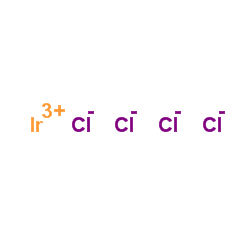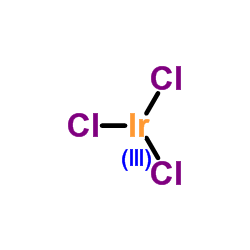iridium(+3) cation tetrachloride
Modify Date: 2025-08-27 07:47:28

iridium(+3) cation tetrachloride structure
|
Common Name | iridium(+3) cation tetrachloride | ||
|---|---|---|---|---|
| CAS Number | 10025-97-5 | Molecular Weight | 334.030 | |
| Density | N/A | Boiling Point | N/A | |
| Molecular Formula | Cl4Ir---- | Melting Point | N/A | |
| MSDS | N/A | Flash Point | N/A | |
| Name | Iridium(IV) Chloride, Premion |
|---|---|
| Synonym | More Synonyms |
| Molecular Formula | Cl4Ir---- |
|---|---|
| Molecular Weight | 334.030 |
| Exact Mass | 332.838867 |
|
Section 1: Product Identification Chemical Name:Iridium (IV) chloride hydrate CAS Registry Number:10025-97-5 Formula:IrCl4.XH2O EINECS Number:none Chemical Family:metal halide Synonym:Iridium tetrachloride
Section 2: Composition and Information on Ingredients IngredientCAS NumberPercentACGIH (TWA)OSHA (PEL) Title Compound10025-97-5100%no datano data Section 3: Hazards Identification Emergency Overview:Irritating to skin, eyes and respiratory tract. Harmful if swallowed. Primary Routes of Exposure:Contact with skin and eyes. Inhalation of dust. Eye Contact:Causes mild irritation to the eyes. Skin Contact:Causes slight irritation of the skin. Inhalation:Inhalation of dust leads to irritation of the respiratory tract. Ingestion:Harmful if swallowed. Acute Health Affects:Irritating to skin, eyes and respiratory tract. harmful if swallowed. Chronic Health Affects:No information available on long-term chronic effects. NTP:No IARC:No OSHA:No SECTION 4: First Aid Measures Immediately flush the eyes with copious amounts of water for at least 10-15 minutes. A victim may need Eye Exposure: assistance in keeping their eye lids open. Get immediate medical attention. Wash the affected area with water. Remove contaminated clothes if necessary. Seek medical assistance if Skin Exposure: irritation persists. Remove the victim to fresh air. Closely monitor the victim for signs of respiratory problems, such as difficulty Inhalation: in breathing, coughing, wheezing, or pain. In such cases seek immediate medical assistance. Seek medical attention immediately. Keep the victim calm. Give the victim water (only if conscious). Induce Ingestion: vomiting only if directed by medical personnel. SECTION 5: Fire Fighting Measures Flash Point:not applicable Autoignition Temperature:none Explosion Limits:none Extinguishing Medium:none required If involved in a fire, fire fighters should be equipped with a NIOSH approved positive pressure self-contained Special Fire Fighting Procedures: breathing apparatus and full protective clothing. Hazardous Combustion andnone Decomposion Products: Unusual Fire or Explosion Hazards: No unusual fire or explosion hazards. SECTION 6: Accidental Release Measures To avoid raising dust, small spills may be mixed with diatomaceous earth, sand, vermiculite or other suitable Spill and Leak Procedures: inert material and swept up. SECTION 7: Handling and Storage Handling and Storage:Store solid in a tightly sealed container. SECTION 8: Exposure Controls and Personal Protection Eye Protection:Always wear approved safety glasses when handling a chemical substance in the laboratory. Skin Protection:Wear appropriate chemical resistant gloves and protective clothing. Ventilation:If possible, handle the material in an efficient fume hood. If in form of fine dust and ventilation is not available a respirator should be worn. The use of respirators Respirator: requires a Respirator Protection Program to be in compliance with 29 CFR 1910.134. Ventilation:If possible, handle the material in an efficient fume hood. Additional Protection:No additional protection required. SECTION 9: Physical and Chemical Properties Color and Form:black pwdr. Molecular Weight:334.03 Melting Point:dec. Boiling Point:no data Vapor Pressure:not applicable Specific Gravity:no data Odor:none Solubility in Water:very soluble SECTION 10: Stability and Reactivity Stability:air and moisture stable Hazardous Polymerization:no hazardous polymerization Conditions to Avoid:none Incompatibility:active metals Decomposition Products:none SECTION 11: Toxicological Information RTECS Data:Oral (rat); LD50: 1560 mg/kg. Carcinogenic Effects:no data Mutagenic Effects:no data Tetratogenic Effects:no data SECTION 12: Ecological Information Ecological Information:No information available SECTION 13: Disposal Considerations Disposal:Dispose of according to local, state and federal regulations. SECTION 14: Transportation Shipping Name (CFR):Non-hazardous Hazard Class (CFR):NA Additional Hazard Class (CFR):NA Packaging Group (CFR):NA UN ID Number (CFR):NA Shipping Name (IATA):Non-hazardous Hazard Class (IATA):NA Additional Hazard Class (IATA):NA Packaging Group (IATA):NA UN ID Number (IATA):NA SECTION 15: Regulatory Information TSCA:Listed in the TSCA inventory. SARA (Title 313):Title compound not listed Second Ingredient:none SECTION 16 - ADDITIONAL INFORMATION N/A |
CHEMICAL IDENTIFICATION
HEALTH HAZARD DATAACUTE TOXICITY DATA
|
| Hazard Codes | Xi |
|---|---|
| Risk Phrases | R34 |
| Safety Phrases | 26-36/37/39:- |
| RIDADR | UN 3260 |
|
~% 
iridium(+3) cat... CAS#:10025-97-5 |
| Literature: Nippon Kagaku Kaishi (Journal of the Chemical Society of Japan), , vol. 63, p. 1938 - 1943 |
| Precursor 0 | |
|---|---|
| DownStream 1 | |
| MFCD00016155 |
| Iridium chloride hydrate |
| EINECS 233-048-8 |
| Iridium chloride(IV) hydrate |
| tetrachloroiridium |
| Iridium(IV) chloride |

 CAS#:10025-83-9
CAS#:10025-83-9
